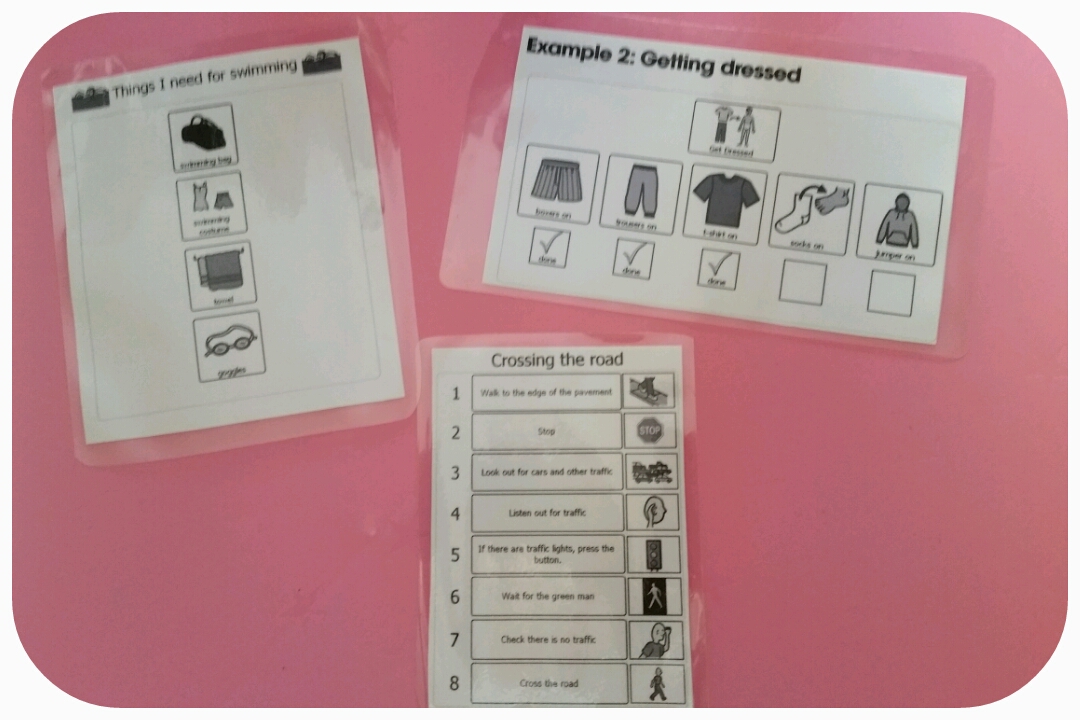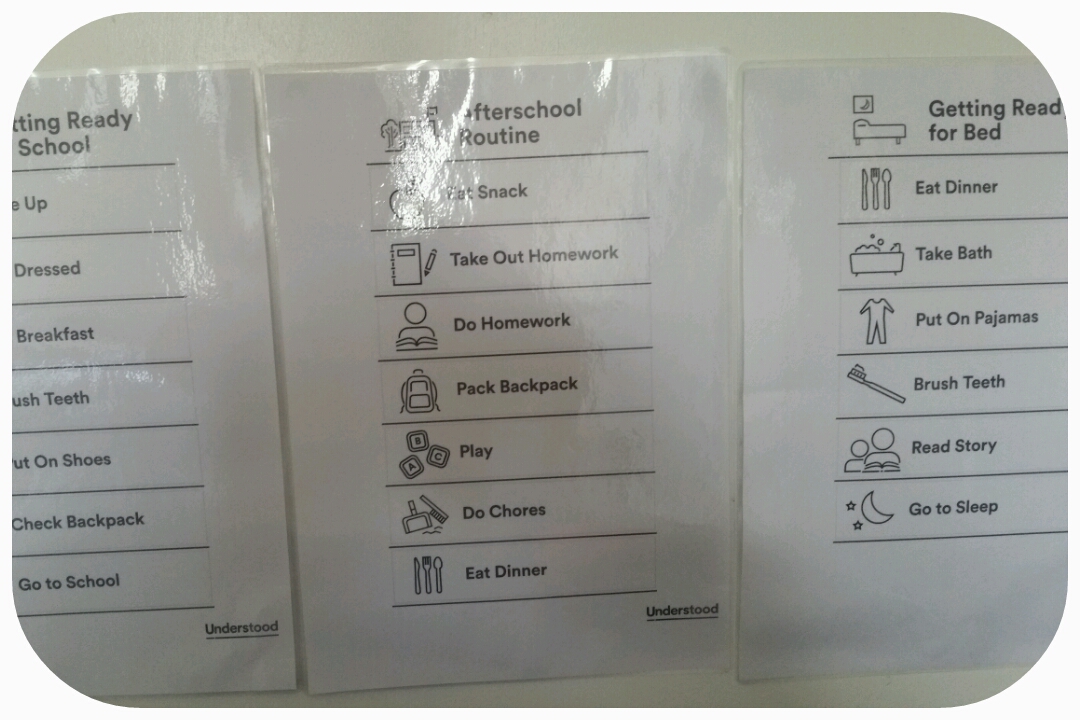Our house is currently covered with visual aids. I’ve used visual prompts in my job role as a teaching assistant, Nursery SENCO (title name in 2009,) and Early Years Teacher. I find the pictures of actual objects work very well with all Early Years children. And I also used the actual objects to show to babies as a prompt, e.g a nappy when it was time to change their nappy.
At first I wondered if visuals would work for Lou, but I discovered that she was responding really well to a ‘Visual Timetable’ and ‘Sign-a-Long'(signing system) at her Early Years setting. Even though Lou is verbal, she may not always understand what is being asked of her or what she is saying herself. Using visuals has aided that ‘Processing Time’ that is so vital for Lou – offering her at least 10 seconds after a question or request. Using a visual is a practical way of getting across a message to her without her having to think really hard about what is being said.
Here is what ‘Autism West Midlands’ state about visual resources:
Why do visual resources help people with autism?
• Many people with autism are ‘visual thinkers’ so information can be easier to process and understand if it is presented visually.
• Visuals are more permanent than words. Once something has been said it can quickly be forgotten or misinterpreted, whereas a visual will always stay the same and can be referred to as many times as needed.
• People with autism can find verbal communication difficult to understand because there are so many different bits of information to process all at once. Visuals allow a person to focus just on what is being communicated, rather than having to decipher the tone of voice, eye contact and body language etc.
• Visuals can help people with autism to express their needs – if someone struggles to communicate verbally, visuals can be used to help them tell others what they want and need.
• Visuals can help to increase independence – for example if a person struggles to get themselves dressed in the mornings, try using a visual prompt to help them understand what they need to do.
How can visual resources support those with challenging behaviour?
• People with autism crave predictability and structure. When there is not enough structure people with autism become anxious. Visuals help to provide this structure and predictability, which reduces anxiety.
• Challenging behaviour can occur when a person with autism cannot express their needs or doesn’t understand what is being communicated to them – visuals can help with this.
• Visuals can be used to help people with autism understand how they are meant to behave and what is expected of them.
• Visuals that incorporate a special interest can help to motivate and reinforce the expected behaviour.
Taken from ‘Using Visual Resources – Introduction. www.autismwestmidlands.org.uk
Illustrated small cards.
These smaller visual cards are very good for aiding processing time, for example, the card that displays putting Pyjamas on is frequently used, also the one for ‘Good Listening.’ When we would like to gain Lou’s attention.
‘Now’ and ‘Then’ boards.
Many times Lou can get overloaded with information, she often wonders what the day will bring and asks every morning (around 6am!) Where are we going today?
This is when the ‘Now’ and ‘Then’ visual prompts are very useful. Where photographs of the actual activities, actions or places are taken:
For the above this displays that ‘Now’ it is craft time and ‘Then’ it is lunch time. This clearly displays the activity or action that is happening now and after to allow Lou to process what is happening, and also reduces the anxieties of not knowing what is happening.
Specific routine visuals.


The above are examples of pre-made specific action or activity timetables that I have printed then laminated.
Traffic Light Visuals.
After recent input from an OT it was suggested that a traffic light system could be used in order to help Lou to understand how she is feeling and to help with sensory overloads.
I designed the above visuals and used actual pictures for:
Green = general activities of choice.
Orange or ‘Amber!’ = activities to help calm/burn energy ~ dancing to music or play dough.
Red = time out in the ‘Calm Zone,’ which is the sensory area situated under our stairs, or to lie on her bed and calm using a weighted blanket.
The aim is for Lou to eventually recognise when she’s feeling a bit overloaded and select an option independently.
Reward systems.
We have tried sticker charts, charts where a hand moves up every time kind hands were used, a ‘Family Starry sky’ where star stickers are added everytime someone in the family achieves something. But nothing has worked as well as the ‘Special Interest’ chart below:

Lou has been a huge ‘Frozen’ fan now for about a year, this chart didn’t take too long to make via a ‘Word’ document, the blue circles are easily copied and pasted and I got some Velcro to enable Lou to add the characters one at a time onto the chart as and when she achieves something. When all 5 discs are achieved Lou receives a reward, which I have been advised, doesn’t always need to be a reward that costs, this can be a trip to the park, or ‘Mummy time’ where Lou and I do a particular activity of her choice without her younger sister present. I have found that Lou is particularly motivated by her current ‘Special Interest’ of ‘Shopkins’ and therefore she enjoys earning the smaller sets or magazines which are not too costly. As a family, we are finding that this chart has helped to encourage Lou to use kind hands and has been hitting out less often, it’s also been beneficial in terms of Lou’s current issue of spitting, this has been occurring less frequently since the introduction of the chart. As the interests change, so can the chart to keep the child’s interests, after Christmas i’ll be changing it to a ‘Shopkins’ chart.

I have found the following sources are amazing for examples of visuals:
- Autism West Midlands –
Help and advice, visual resources
There are some really helpful guides to using visual resources and they offer some printable resources.
- Do2Learn –
Here there are also fantastic ‘Social Stories’ that we have used with Lou, these are visual stories where steps of an event or practice are shown in order. We used a Social Story when Lou had to go to the local hospital for her Microarray blood test and we were amazed how well she coped with the experience. Social stories can be used for a visit to the doctors, dentists, hospital, park, play dates, parties, etc. There is more-or-less a Social Story for any event.

- Understood – here we were able to print off the routine visuals for bedtimes, getting ready for school, etc.
For more information on ‘Sign-a-Long’ please visit:
Thank you for reading 🙂
If anyone has any queries on visuals please contact me at:






You must be logged in to post a comment.